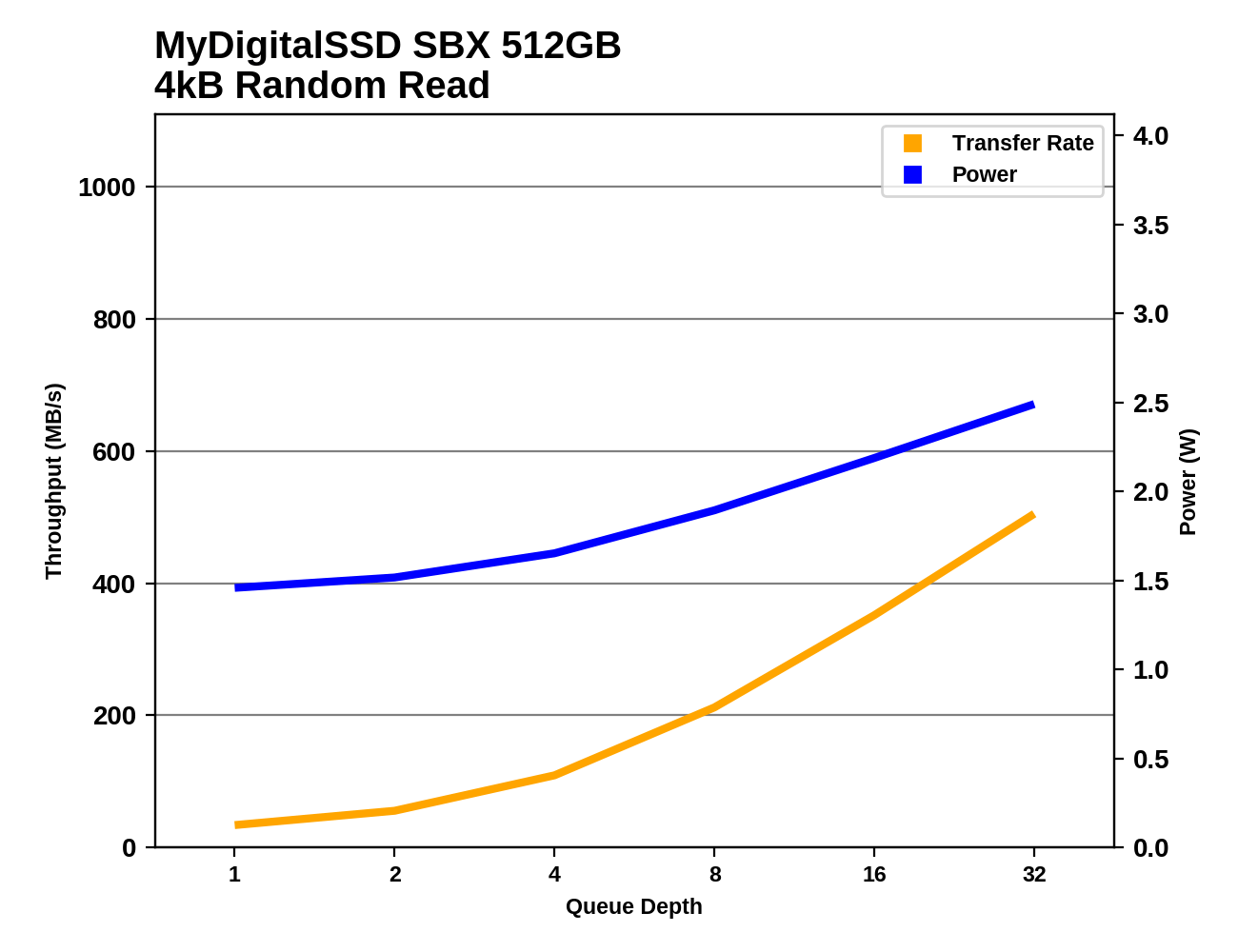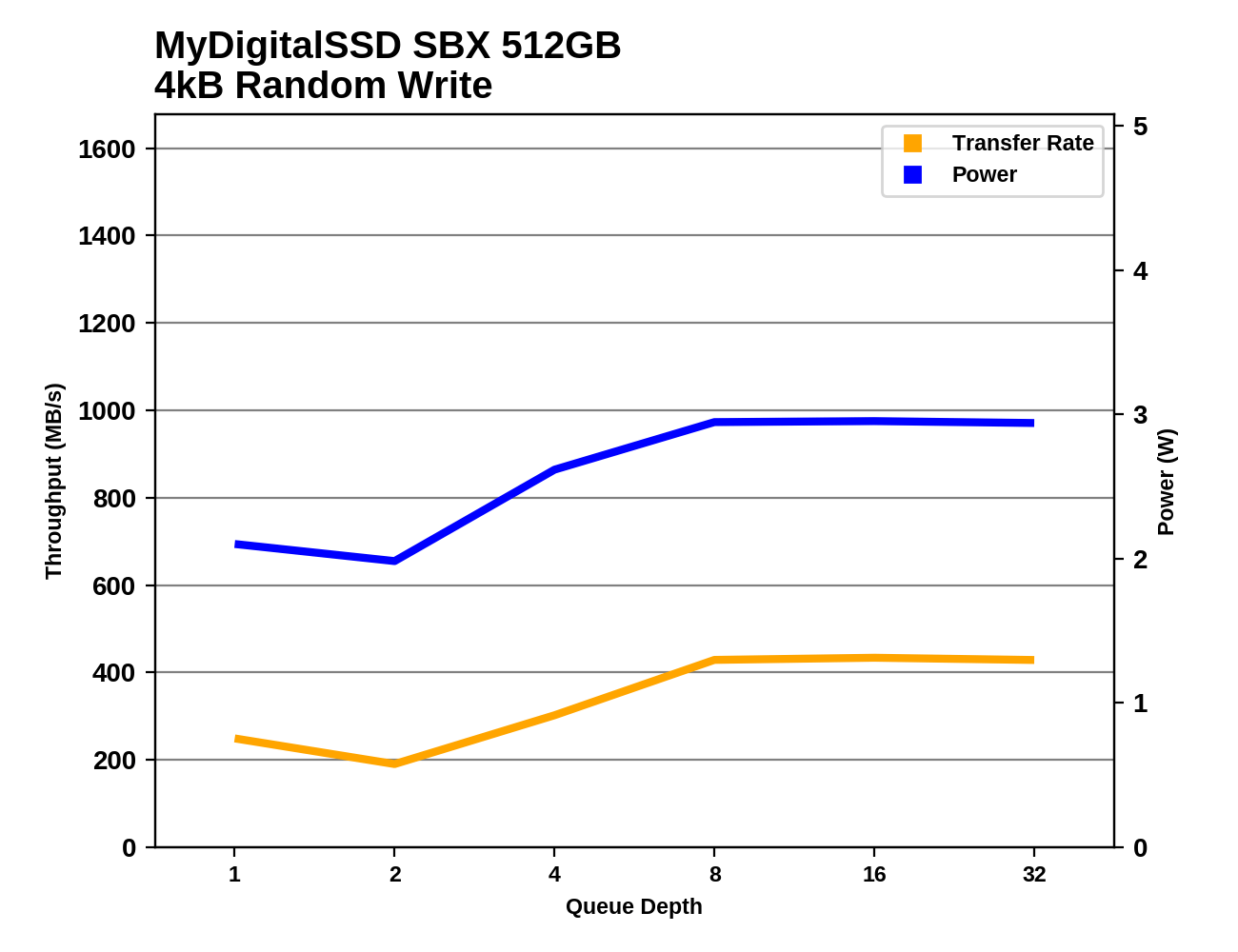The MyDigitalSSD SBX SSD Review: NVMe On The Cheap
by Billy Tallis on May 1, 2018 8:05 AM ESTRandom Read Performance
Our first test of random read performance uses very short bursts of operations issued one at a time with no queuing. The drives are given enough idle time between bursts to yield an overall duty cycle of 20%, so thermal throttling is impossible. Each burst consists of a total of 32MB of 4kB random reads, from a 16GB span of the disk. The total data read is 1GB.

The QD1 burst random read performance of the MyDigitalSSD SBX is relatively poor, falling behind the top tier of SATA SSDs. The SBX is faster than the Intel SSD 600p, but the newer Intel 760p is more than 50% faster than the SBX.
Our sustained random read performance is similar to the random read test from our 2015 test suite: queue depths from 1 to 32 are tested, and the average performance and power efficiency across QD1, QD2 and QD4 are reported as the primary scores. Each queue depth is tested for one minute or 32GB of data transferred, whichever is shorter. After each queue depth is tested, the drive is given up to one minute to cool off so that the higher queue depths are unlikely to be affected by accumulated heat build-up. The individual read operations are again 4kB, and cover a 64GB span of the drive.

The ranking of the MyDigitalSSD SBX doesn't change much on the longer random read test, but many of the faster drives have traded places. Even with some higher queue depths involved, the SBX can't quite match the best SATA SSDs for random read performance.
 |
|||||||||
| Power Efficiency in MB/s/W | Average Power in W | ||||||||
The MyDigitalSSD SBX draws substantially less power during the random read test than most NVMe SSDs, which leads to an efficiency score that is about average. Many of the SATA drives have a significant efficiency advantage, as do several of the fastest NVMe SSDs.
 |
|||||||||
The 512GB SBX clearly has room for further throughput increases past QD32, but the smaller capacities start falling behind past QD4 and are close to saturation by QD32. The Intel SSD 760p shows similar performance scaling that is almost always a bit faster than the SBX, but also requires significantly more power across the board.
Random Write Performance
Our test of random write burst performance is structured similarly to the random read burst test, but each burst is only 4MB and the total test length is 128MB. The 4kB random write operations are distributed over a 16GB span of the drive, and the operations are issued one at a time with no queuing.

The burst random write performance of the MyDigitalSSD SBX can't match the unusually good performance from the Intel SSD 760p, but it is certainly reasonable for a low-end NVMe SSD. The 128GB SBX is about 30% slower than the larger capacities, but is still faster than the SATA drives.
As with the sustained random read test, our sustained 4kB random write test runs for up to one minute or 32GB per queue depth, covering a 64GB span of the drive and giving the drive up to 1 minute of idle time between queue depths to allow for write caches to be flushed and for the drive to cool down.

On the longer random write test, SLC cache size limitations come into play and the 128GB drives end up near the bottom of the chart, above only the DRAMless SATA drives. The larger capacities aren't quite as fast as the top SATA SSDs, and the more expensive NVMe SSDs offer more than double the throughput of the SBX even at these relatively low queue depths.
 |
|||||||||
| Power Efficiency in MB/s/W | Average Power in W | ||||||||
The SBX is again using much less power than the other NVMe SSDs, but its poor performance leaves it with a fairly low efficiency score.
 |
|||||||||
Performance from the SBX drops during the early phases of the random write test as the SLC write cache is quickly filled. Only the 512GB model manages to recover performance later at high queue depths, but its eventual limit is not far above the performance offered by SATA drives.










46 Comments
View All Comments
Mikewind Dale - Tuesday, May 1, 2018 - link
I'd like to see a low performance M.2 PCIe to USB enclosure just to make it easier to format and transfer drives. E.g., suppose you have a laptop with one M.2, and you want to upgrade. You'll have to make a disk image from M.2 PCIe, copy it to a SATA USB drive, then install the new M.2 drive and copy the image. You need a third drive in between. It'd be nice to copy straight from one M.2 drive to the other.dgingeri - Tuesday, May 1, 2018 - link
Well, as far as that goes, it would be nice if laptop makers would replace the 3.5" bay with two m.2 slots so it wouldn't be so much trouble for those very things. However, it seems laptop makers have their heads about as far up their behinds as is possible.peevee - Friday, May 4, 2018 - link
You will have zero benefit from NVMe on USB 3.0. Maybe USB 3.2.Samus - Tuesday, May 1, 2018 - link
Is there some reason the WD Black NVMe results are missing from all your charts, when you just did a review of that drive?Seems kind of weird considering it's this drives natural competitor.
Billy Tallis - Tuesday, May 1, 2018 - link
The new WD Black is more of a high-end NVMe drive in both price and performance. I didn't want to make the graphs too large, and I only have 1TB samples of the WD Black so it wouldn't be a fair comparison against the 512GB and smaller SBX.Dragonstongue - Tuesday, May 1, 2018 - link
seems that Crucial MX500 is a VERY good drive taking everything into accountprice is "reasonable" performance is also "reasonable" given the price.
to each their own, I kind of like the good ol 2.5" sata drive, they do not seem to have any throttle from heat related crud that so many of the u2 or m2 (whatever version you want to call them)
as pretty much all mobo put them really close to massive heat producing parts such as cpu or gpu and those stupid heatshields 9/10 are useless as crud ^.^
the other side of NVME based is not only does your motherboard have to support such (from OS as well as mobo point of view) seems there are many of them out there that are not as plug and play as they should be considering the cost IMO.
I am ok with a corvette over a station wagon (i.e SSD vs HDD) I do not have need to pay that extra $$$$$$ for a ferrari (that seems that given the proper workload are obviously WAY faster, but, run of the mill race, SSD are already fast enough and much more costly than a standard HDD to begin with)
moheban79 - Wednesday, May 2, 2018 - link
Anyone know if these nvme drives come with legacy option roms?peevee - Thursday, May 3, 2018 - link
Looks to me the drives were not in NVMe mode. Random performance should not be so much lower than SATA drives.MajGenRelativity - Thursday, May 3, 2018 - link
NVMe is not a "mode", and random performance is dependent on the drive, not the interface (up to a point)dgingeri - Friday, May 4, 2018 - link
Actually, yes, NVMe is a mode. The other mode is AHCI under PCIe, and all NVMe drives can operate in AHCI mode, and yes it does hurt random performance because the instruction parallelism allowed isn't nearly as wide under AHCI mode.https://www.anandtech.com/show/7843/testing-sata-e...